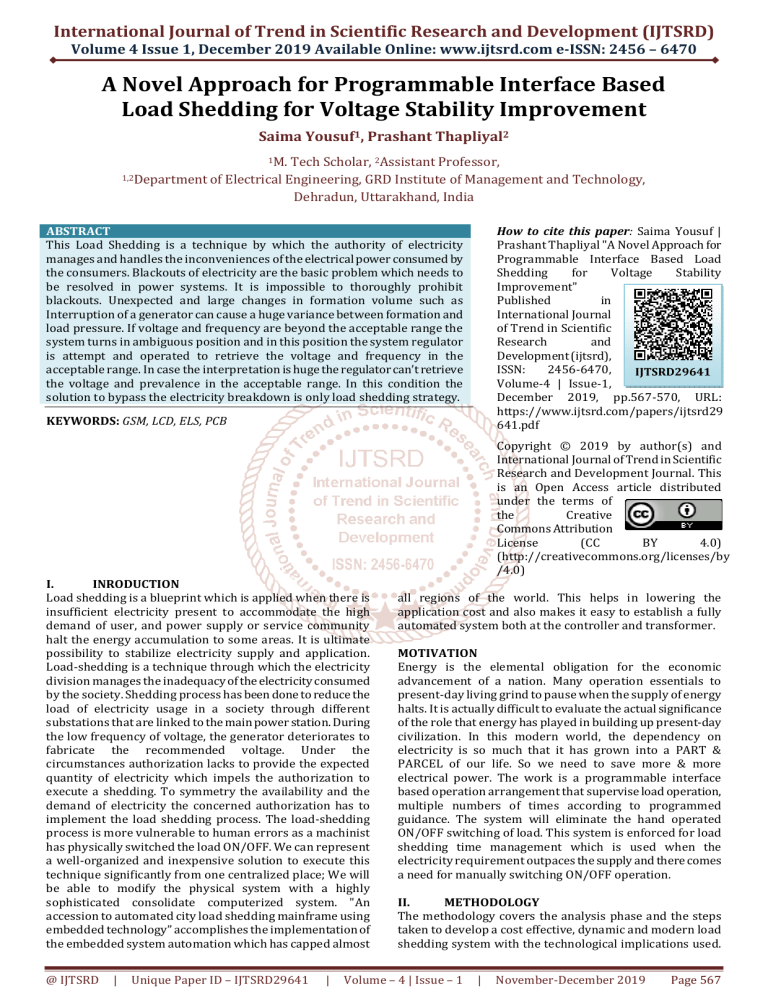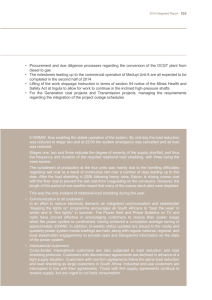
International Journal of Trend in Scientific Research and Development (IJTSRD)
Volume 4 Issue 1, December 2019 Available Online: www.ijtsrd.com e-ISSN: 2456 – 6470
A Novel Approach for Programmable Interface Based
Load Shedding for Voltage Stability Improvement
Saima Yousuf1, Prashant Thapliyal2
1M.
Tech Scholar, 2Assistant Professor,
1,2Department of Electrical Engineering, GRD Institute of Management and Technology,
Dehradun, Uttarakhand, India
How to cite this paper: Saima Yousuf |
Prashant Thapliyal "A Novel Approach for
Programmable Interface Based Load
Shedding
for
Voltage
Stability
Improvement"
Published
in
International Journal
of Trend in Scientific
Research
and
Development (ijtsrd),
ISSN:
2456-6470,
IJTSRD29641
Volume-4 | Issue-1,
December 2019, pp.567-570, URL:
https://www.ijtsrd.com/papers/ijtsrd29
641.pdf
ABSTRACT
This Load Shedding is a technique by which the authority of electricity
manages and handles the inconveniences of the electrical power consumed by
the consumers. Blackouts of electricity are the basic problem which needs to
be resolved in power systems. It is impossible to thoroughly prohibit
blackouts. Unexpected and large changes in formation volume such as
Interruption of a generator can cause a huge variance between formation and
load pressure. If voltage and frequency are beyond the acceptable range the
system turns in ambiguous position and in this position the system regulator
is attempt and operated to retrieve the voltage and frequency in the
acceptable range. In case the interpretation is huge the regulator can’t retrieve
the voltage and prevalence in the acceptable range. In this condition the
solution to bypass the electricity breakdown is only load shedding strategy.
KEYWORDS: GSM, LCD, ELS, PCB
Copyright © 2019 by author(s) and
International Journal of Trend in Scientific
Research and Development Journal. This
is an Open Access article distributed
under the terms of
the
Creative
Commons Attribution
License
(CC
BY
4.0)
(http://creativecommons.org/licenses/by
/4.0)
I.
INRODUCTION
Load shedding is a blueprint which is applied when there is
insufficient electricity present to accommodate the high
demand of user, and power supply or service community
halt the energy accumulation to some areas. It is ultimate
possibility to stabilize electricity supply and application.
Load-shedding is a technique through which the electricity
division manages the inadequacy of the electricity consumed
by the society. Shedding process has been done to reduce the
load of electricity usage in a society through different
substations that are linked to the main power station. During
the low frequency of voltage, the generator deteriorates to
fabricate the recommended voltage. Under the
circumstances authorization lacks to provide the expected
quantity of electricity which impels the authorization to
execute a shedding. To symmetry the availability and the
demand of electricity the concerned authorization has to
implement the load shedding process. The load-shedding
process is more vulnerable to human errors as a machinist
has physically switched the load ON/OFF. We can represent
a well-organized and inexpensive solution to execute this
technique significantly from one centralized place; We will
be able to modify the physical system with a highly
sophisticated consolidate computerized system. "An
accession to automated city load shedding mainframe using
embedded technology” accomplishes the implementation of
the embedded system automation which has capped almost
@ IJTSRD
|
Unique Paper ID – IJTSRD29641
|
all regions of the world. This helps in lowering the
application cost and also makes it easy to establish a fully
automated system both at the controller and transformer.
MOTIVATION
Energy is the elemental obligation for the economic
advancement of a nation. Many operation essentials to
present-day living grind to pause when the supply of energy
halts. It is actually difficult to evaluate the actual significance
of the role that energy has played in building up present-day
civilization. In this modern world, the dependency on
electricity is so much that it has grown into a PART &
PARCEL of our life. So we need to save more & more
electrical power. The work is a programmable interface
based operation arrangement that supervise load operation,
multiple numbers of times according to programmed
guidance. The system will eliminate the hand operated
ON/OFF switching of load. This system is enforced for load
shedding time management which is used when the
electricity requirement outpaces the supply and there comes
a need for manually switching ON/OFF operation.
II.
METHODOLOGY
The methodology covers the analysis phase and the steps
taken to develop a cost effective, dynamic and modern load
shedding system with the technological implications used.
Volume – 4 | Issue – 1
|
November-December 2019
Page 567
International Journal of Trend in Scientific Research and Development (IJTSRD) @ www.ijtsrd.com eISSN: 2456-6470
The concept is developed using Proteus tool with Kiel. The
Proteus is very popular tool used for design automation to
create schematic and electronic points. Kiel offers debuggers,
IDE, compilers, RTOS, library managers for wide range of
micro-controllers.
III.
RESULTS
The results obtained during simulation phase are described below:
In this condition “0”, our system will turn on the load or power supply immediately, once the timer is set using keys
In this condition “1”, our system will turn “OFF” the power supply as per timer is set using push buttons.
In this condition “2”, our system will turn ON and OFF the power supply as per timer is set and vice versa i.e., first OFF and
then ON the power supply as per input is given by the user.
@ IJTSRD
|
Unique Paper ID – IJTSRD29641
|
Volume – 4 | Issue – 1
|
November-December 2019
Page 568
International Journal of Trend in Scientific Research and Development (IJTSRD) @ www.ijtsrd.com eISSN: 2456-6470
The output load or power supply turns ON as per the input set by the user
IV.
PARAMETERS USED
Set
Condition
Setting Up Values
Current Time
Condition 0
00:05:32 (HH:MM:SS)
09:40:10 (HH:MM:SS)
Condition 1
00:02:15(HH:MM:SS)
09:48:07 (HH:MM:SS)
Condition of load(Output power
supply)
The output power supply will trigger at
time interval of 5 min and 32 seconds,
starting from 09:40:10
The output power supply will turn ON
after the time period of 2 min and 15
seconds, counting from 09:48:07
09:52:15(HH:MM:SS)
The output power will turn OFF for a
period of 1 hr, 5 min and 23 seconds and
turn ON for a period of 2 hr, 9 min and
15 seconds, starting from 09:52:15
Sub Condition 1:
TIMER 1:- 01:05:23 (HH:MM:SS)
TIMER 2:- 02:09:15(HH:MM:SS)
Condition 2
The output power will turn ON for a
period of 3hr,23min and 12 seconds and
is turned OFF for a period of 1hr, 17
mins and 03 seconds, starting from
12:35:06
Sub Condition 2:TIMER 1:- 03:23:12(HH:MM:SS)
TIMER 2:-01:17:03(HH:MM:SS)
12:35:06(HH:MM:SS)
V.
CONCLUSION
The programmable based load shedding system helps in
improving the standard and stability of power grid. The
paper presents the design of programmable interface based
Load Shedding System for improving voltage stability with
motivation and research methodology implemented.
REFERENCES:
[1] Abhishek Pawar and Zainab Mizwan, “An Embedded
Technology Based Automated City Load Shedding
Management Scheme”, International Journal of
Innovative Research in Computer and Communication
Engineering, Volume-6, Issue-10, October 2018.
[2] Abhishek Pawar and Zainab Mizwan, “Time based
electricity and load shedding monitoring using
embedded systems”, International Journal of
Innovative Research in Computer and Communication
Engineering, Volume-4, Issue-4, 2018.
[3] Noor Ullah, M.Idrees, Taimoor Mohsin, M.Usama and
Imtiaz Ali Shah, “Priority Based Load Management
System UsingBluetooth Device”, International Journal
@ IJTSRD
|
Unique Paper ID – IJTSRD29641
|
of Engineering and Advanced Technology (IJEAT),
Volume-7 Issue-3, February 2018.
[4] Sushma .S.R, Sowmya .P, SeethaLakshmi .H.R,
Sowmyashree .S.R, “Automated Load Shedding and
Notification to the Consumers using GSM”,
International Journal of Engineering Science and
Computing, volume-7, issue-5, may 2017.
[5] Ankit Vijayvargiya1, Abhishek Bansal2, Abhishek
Sharma3, Aditya Jain4 and Akash5, “Effective Load
Shedding Technique for Utility Department”,
International Journal of Engineering and Management
Research, Volume-6, Issue-2, March-April 2016.
[6] Prof. S. K. Bhatia, Kshirsagar Navin H, Lad Sayali
S.,Waghmare Namdev n, “Auto Load Shedder For
Electricity Board Using GSM Technique”, international
Engineering Research Journal(IERJ) Volume-2 Issue-1,
2015
[7] Patil PT, Dattatraya raut, Sagar Sutar and Sandesh
Narute, “GSM Based Wireless Load-Shedding
Volume – 4 | Issue – 1
|
November-December 2019
Page 569
International Journal of Trend in Scientific Research and Development (IJTSRD) @ www.ijtsrd.com eISSN: 2456-6470
Management System for Nonemergency Condition”,
International Journal of Modern Trends in Engineering
and Research, Volume-2, Issue-1,January 2015.
[12] Jianyuan Xu,Weifu Qi,Lu Wang1 and Yuying Liu,
“Study of Load Shedding Procedure for Power
SystemVoltage Stability”, 2010.
[8] Snehal K Gosavi, Khushbu D Badgujar and Prafulla
P.Chaudhari, “Electricity And Load Shedding
Monitoring”, International Journal of Advanced
Research in Electronics and Communication
Engineering, Volume-4, Issue-3, March 2015.
[13] Roberto Faranda, Antonio Pievatolo, and Enrico Tironi,
“Load Shedding: A New Proposal”, Volume-22, Issue-4,
November 2007.
[9] Dwijen Rudrapal, Smita Das, Agnivesh Pandey and
Nirmalya Kar, “Automated Load Shedding Period
Control System”, International Journal on Computer
Science and Engineering (IJCSE), 09 April 2015.
[10] Huy Anh Quyen, Quang Anh Bui, Trong Nghia Le, and
Tan Thanh Tung Le, “Optimal Load Shedding Based on
Frequency, Voltage Sensitivities and AHP Algorithm”,
2014.
[11] Ghazanfar Shahgholian, “Effect of Load Shedding
Strategy on Interconnected Power Systems Stability
When a Blackout Occurs”, International Journal of
Computer and Electrical Engineering, Volume- 4, Issue
2, April 2012.
@ IJTSRD
|
Unique Paper ID – IJTSRD29641
|
[14] G. Giannuzzi, D. Lucarella, S. Massucco, M. Pozzi, M.
Sforna and F. Silvestro, “Advanced Load-shedding
Methodology and Architecture for Normal and
Emergency Operation of the Italian Power System”,
July 2005.
[15] N.Perumal and Aliza Che Amran, “Automatic Load
Shedding in Power System”, National Power and
Energy Conference, 2003.
[16] Nova Ahmed and Umakishore Ramachandran, “Load
Shedding Based Resource Management Techniques for
RFID Data”.
[17] XU Xing-wei, Cao Xiaoping , Liu Rao and Li Weidong,
“Research on the Automatic Electricity Use Restricting
Load-shedding”.
Volume – 4 | Issue – 1
|
November-December 2019
Page 570




